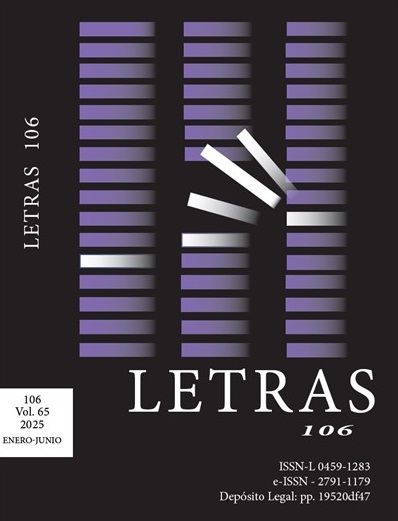The last revolutionary: Ernesto, dramatic text by Rafael Minvielle
DOI:
https://doi.org/10.56219/letras.v65i106.3912Keywords:
Minvielle, semantic macrostructures, macropropositions, dramatic compositionAbstract
This article carries out a textual analysis of the selected play. Within the framework of such methodology, we will work in terms of semantic macrostructures; that is, themes and macro- propositions as basic categories. The above aims to demonstrate that El mundo dramático de Ernesto, a work written and published in 1842 by the Spaniard living in Chile, Rafael Minvielle, was a creation that revealed and disseminated the ideologies that reproduced or resisted power through its two main characters. Consequently, the reading developed is based on the premise that Minvielle's dramatic composition, directly influenced by the context of production and as a political instrument at the service of the recent nation, instills a set of values and aspirations that interpret the country's feelings. At the time of the publication of the text, the country was emerging from a period of transition and instability (revolutionary struggle for independence, prior to the 1920s, plus the subsequent civil war of 1829-30), and was looking for principles that would allow it to project itself with certainty into the civil and political future.
Downloads
References
Aguilar, L. (2017). Una reconstrucción del concepto de opinión pública. Revista Mexicana de Opinión Pública, 23 (I), 125-148. DOI: https://doi.org/10.22201/fcpys.24484911e.2017.23.60908
Amunátegui, M. (1888). Las primeras representaciones dramáticas en Chile. Imprenta Nacional.
Berman, M. (1989). Todo lo sólido se desvanece en el aire. La experiencia de la modernidad. Siglo XXI.
Bottinelli, A. (2015). Letrados: Poder fundacional, escritura y política en el sur americano. En Key tropes in inter-American studies: Perspectives from the forum of inter-american research. W. Raussert, B., Rozema, Y., Campos & M. Littschwager (Eds.) (pp. 53-72). WissenschaftlicherVerlag Trier.
Bowen, M. (2006). Distraer y gobernar: teatro y diversiones públicas en Santiago de Chile durante la era de las revoluciones (1780-1836). Historia, 49, 27-56. DOI: https://doi.org/10.4067/S0717-71942016000100002
Bravo Lira, B. (1992). El absolutismo ilustrado en Hispanoamérica, Chile (1760-1860). De Carlos III a Portales y Montt. Editorial Universitaria.
Bravo Lira, B. (1999) Por la razón o la fuerza. El Estado de Derecho en la historia de Chile. Ediciones Universidad Católica de Chile.
Collier, S., Sater, W. (1999). Historia de Chile (1808 -1994). (M. Grass, Trad.). University Pres.
Debesa, F. (1979, 28 de enero). “Ernesto, de Rafael Minvielle”. El Mercurio, E6.
Faúndez Carreño, T. (2014). La guerra en la dramaturgia chilena. (Tesis de Doctorado en Estudios Teatrales). Universidad Autónoma de Barcelona, Facultad de Filosofía y Letras.
Hopenhayn, M. (2004). Ni apocalípticos ni integrados. Aventuras de la modernidad en América Latina. Santiago de Chile: Fondo de Cultura Económica.
Lastarria, J. V. (1967). Recuerdos literarios. Zig-Zag.
Lavasi, M. (abril 2014). Alumbrar la oscuridad con la palabra. Ernesto. https://www.researchgate.net/publication/281285528.
Mandoki, K. (2007). La construcción estética del estado y de la identidad nacional. Prosaica III. Siglo XXI.
Minvielle, R. (1842). Ernesto. Drama original en prosa y en tres actos. Imprenta del Progreso.
Pascual y Beltrán, V. (1944). Un setabense ilustre, desconocido en Játiva, celebrado en América: D. Rafael Minvielle Lamaneta. Saitabi, Revista de la Facultad de Geografía e Historia, Universidad de Valencia, 2(12), 137-151.
Peña, N. (Ed.). (1912). Teatro Dramático Nacional. Tomo I. Imprenta Barcelona.
Pinilla, N. (1942). Panorama y significación del Movimiento literario de 1842. Ediciones de la Universidad de Chile.
Retamal, C. (2016). Lo que queda después de que todo lo sólido se desvanece en el aire. En Debates Contemporáneos (pp. 255-275). RIL Editores.
Salvat Monguillot, M. (1978). Aspectos histórico-jurídicos del Ernesto, de Rafael Minvielle. Revista Chilena de Historia del Derecho, 7, 193–197.
Subercaseaux, B. (2007). Historia de las ideas y de la cultura en Chile. Tomo I. Sociedad y cultura liberal en el siglo XIX: J.V. Lastarria. Editorial Universitaria.
Van Dijk, T. (2003). “La multidisciplinaridad del análisis crítico del discurso: un alegato en favor de la diversidad.” En Ruth Wodak & Michael Meyer, Métodos de análisis crítico del discurso. Gedisa, pp. 143-177.
Published
How to Cite
Issue
Section
License
Copyright (c) 2025 LETRAS

This work is licensed under a Creative Commons Attribution-NonCommercial-ShareAlike 4.0 International License.
Letras magazine retains the patrimonial rights (copyright) of the published works, which favors and allows their reuse under the license (CC BY - NC - SA 4.0), for which they can be copied, used, disseminated, transmitted and expose publicly, as long as the authorship and original source of its publication (magazine, publisher, URL and DOI of the work) is cited, they are not used for commercial or onerous purposes and the existence and specifications of this use license are mentioned.















